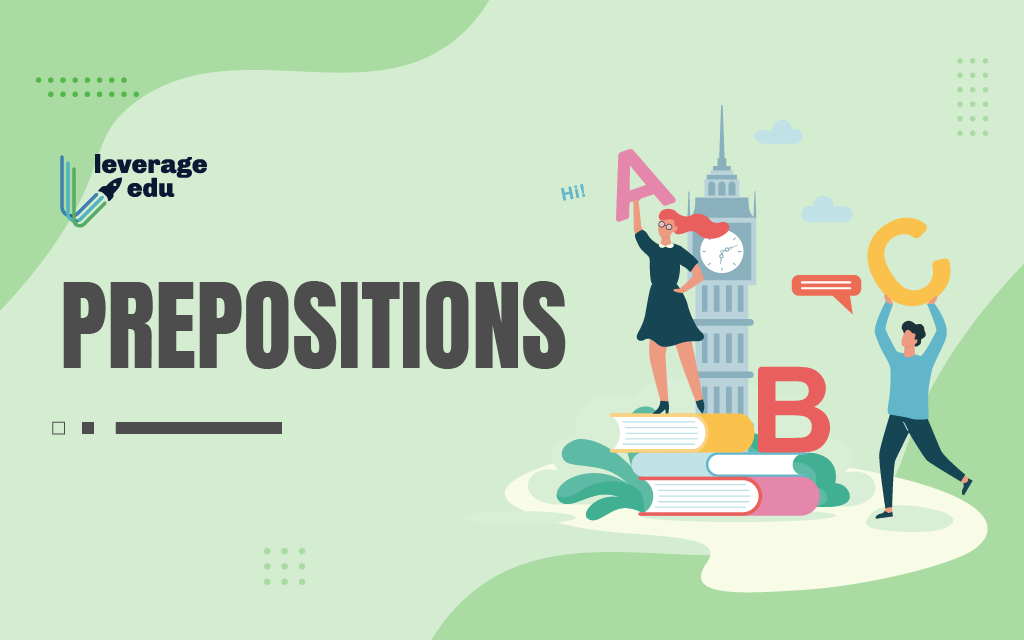How to Use Prepositions Correctly?
A preposition is an important topic in government and other competitive exams. Prepositions are an important part of… The post How to Use Prepositions Correctly? appeared first on Leverage Edu.


A preposition is an important topic in government and other competitive exams. Prepositions are an important part of English grammar. English may look easy but sometimes grammar nazis are not able to crack the prepositions questions. The basic rules taught in the CBSE primary classes turn out to be a part of competitive exams. Let us explore different rules for prepositions and usage with some examples!
Also Read : Learn All About Adjectives in English Grammar!
What is Preposition?
Prepositions and postpositions together known as the adpositions are a class of words generally used to create a relation between the noun, the pronoun, and other parts of the sentence. Examples of prepositions, in, under, towards, before, of, for, etc.
Also Read : Quiz Your Inner Grammar Nazi With this Grammar Test
Rules for Prepositions
There are 6 simple and easy-to-learn rules that will help you ace the grammatical section of various competitive exams. Here are the 6 rules for prepositions:
- Rule 1- Prepositions must have an object
- Rule 2- Must be placed before
- Rule 3- The Pronoun following the Preposition should be an object form
- Rule 4- Prepositions form
- Rule 5- Do not confuse preposition ‘to’ with infinitive ‘to’
- Rule 6- A Verb cannot be an object of a preposition
Also Read : How F.R.I.E.N.D.S. Helped People to Learn English!
Use of Prepositions with Examples
Examples are a great way to understand the essence of the topic. It helps you understand the usage, types, and differences. Here is a detailed description of rules for prepositions with examples:
Prepositions must have an object
It is mandatory for prepositions to have an object. Without an object, the preposition is merely an adverb. A preposition always has an object whereas an adverb never has an object. Let’s understand it better with the help of some examples:
- He is in the kitchen
(Preposition “in” has an object the kitchen)
Please come in
(It is an adverb, since “in” has no object)
- There was a table before me
(Preposition “before” has to object me)
Vicky had never seen it before
(Adverb “before” has no object)
- They will catch up after the movie
(Preposition”after” has an object “movie”)
Aarav called soon after
(Adverb “after” has no object)
Preposition means place before
This rule states that generally, Preposition comes before its object but not always. A preposition comes before a noun or a pronoun. Let’s understand this rule for prepositions with some examples:
- She put the things in the box
(“In” has an object box, and is placed before “box”)
You can not end a sentence with a preposition, and it is a very popular myth of English grammar. But the truth is you can make a sentence with a preposition. For example:-
- Who did you talk to?
(Preposition “to” related to the pronoun “who”)
Pronoun following the Preposition should be an object form
The noun or pronoun following a preposition forms a prepositional object. If a pronoun is following a preposition, it should be in the objective form ( me, her, them) and not the subjective form like (I, she, they, etc.). Look at the examples below:
- The gift is from Ravi and Ruchita
- The secret is between me and you
Prepositions Form
Prepositions particularly have no form. Most of the prepositions are one word only, but there are some two to three-word prepositions and they are known as complex prepositions. Let’s take the help of examples to understand the concept with clarity:
- One word prepositions like before, on, into
- Complex Prepositions like according to, in spite of, on account of, but for
Do not confuse the preposition ‘to’ with the infinitive ‘to’
“To” is used as a Preposition (like to me, to India) as well as “to” is an infinitive participle too (to eat, to dance, to sing, etc.). Be aware and don’t mix the two different things. Here are few examples fore more clarity:
To as a Preposition
- I am used to painting
- I look forward to seeing you (Don’t use see you)
To as an Infinitive Participle
- I used to live in America
- They love to sing
Verb cannot be an object of a preposition
This is the Golden rule of Preposition. Sometimes it happens that words that look like verbs are followed by prepositions “to” but a verb can never be an object of a preposition. Confusing right? Let’s understand it with an example:
- I like to sing
- These guitars are for singing
In the examples above, “sing” and “singing” are not verbs. In the first example, to sing is part of the infinitive and it occurs when a verb is used as a noun, adverb, or adjective. Here, to sing is not an action that is being performed, but what a person likes doing.
In the second example, singing is a ‘gerund’ which is basically a noun, though it is formed out of a verb. Her singing is the thing to which the guitars are related. No one in this sentence is actually singing.
Check Out Other Important Topics of English
- Rules and List of Conjunctions
- Improve your English Vocabulary for IELTS Writing and Speaking
- Article Rules
- Degree of Comparison Rules
- Reported Speech Rules With Exercises
- Tenses Rules and Examples
This was all about the rules for prepositions. We hope you liked this blog & will help you in preparation. For the latest updates around study blogs, you can follow us on Instagram, Twitter, Facebook & also subscribe to our newsletter. Leverage Edu wishes you all the best for all your future endeavors.
The post How to Use Prepositions Correctly? appeared first on Leverage Edu.

![How To Obtain NECO GCE Registration Form For 2022/2023 (November/December) SSCE External Examination [Released And Published Online]](https://micplustech.com/wp-content/uploads/2020/02/images-33.jpeg)







